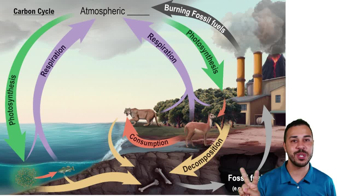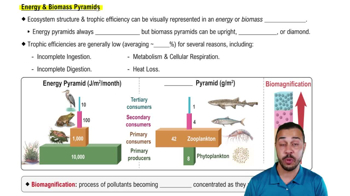Table of contents
- 1. Introduction to Biology2h 40m
- 2. Chemistry3h 40m
- 3. Water1h 26m
- 4. Biomolecules2h 23m
- 5. Cell Components2h 26m
- 6. The Membrane2h 31m
- 7. Energy and Metabolism2h 0m
- 8. Respiration2h 40m
- 9. Photosynthesis2h 49m
- 10. Cell Signaling59m
- 11. Cell Division2h 47m
- 12. Meiosis2h 0m
- 13. Mendelian Genetics4h 41m
- Introduction to Mendel's Experiments7m
- Genotype vs. Phenotype17m
- Punnett Squares13m
- Mendel's Experiments26m
- Mendel's Laws18m
- Monohybrid Crosses16m
- Test Crosses14m
- Dihybrid Crosses20m
- Punnett Square Probability26m
- Incomplete Dominance vs. Codominance20m
- Epistasis7m
- Non-Mendelian Genetics12m
- Pedigrees6m
- Autosomal Inheritance21m
- Sex-Linked Inheritance43m
- X-Inactivation9m
- 14. DNA Synthesis2h 27m
- 15. Gene Expression3h 20m
- 16. Regulation of Expression3h 31m
- Introduction to Regulation of Gene Expression13m
- Prokaryotic Gene Regulation via Operons27m
- The Lac Operon21m
- Glucose's Impact on Lac Operon25m
- The Trp Operon20m
- Review of the Lac Operon & Trp Operon11m
- Introduction to Eukaryotic Gene Regulation9m
- Eukaryotic Chromatin Modifications16m
- Eukaryotic Transcriptional Control22m
- Eukaryotic Post-Transcriptional Regulation28m
- Eukaryotic Post-Translational Regulation13m
- 17. Viruses37m
- 18. Biotechnology2h 58m
- 19. Genomics17m
- 20. Development1h 5m
- 21. Evolution3h 1m
- 22. Evolution of Populations3h 52m
- 23. Speciation1h 37m
- 24. History of Life on Earth2h 6m
- 25. Phylogeny2h 31m
- 26. Prokaryotes4h 59m
- 27. Protists1h 12m
- 28. Plants1h 22m
- 29. Fungi36m
- 30. Overview of Animals34m
- 31. Invertebrates1h 2m
- 32. Vertebrates50m
- 33. Plant Anatomy1h 3m
- 34. Vascular Plant Transport2m
- 35. Soil37m
- 36. Plant Reproduction47m
- 37. Plant Sensation and Response1h 9m
- 38. Animal Form and Function1h 19m
- 39. Digestive System10m
- 40. Circulatory System1h 57m
- 41. Immune System1h 12m
- 42. Osmoregulation and Excretion50m
- 43. Endocrine System4m
- 44. Animal Reproduction2m
- 45. Nervous System55m
- 46. Sensory Systems46m
- 47. Muscle Systems23m
- 48. Ecology3h 11m
- Introduction to Ecology20m
- Biogeography14m
- Earth's Climate Patterns50m
- Introduction to Terrestrial Biomes10m
- Terrestrial Biomes: Near Equator13m
- Terrestrial Biomes: Temperate Regions10m
- Terrestrial Biomes: Northern Regions15m
- Introduction to Aquatic Biomes27m
- Freshwater Aquatic Biomes14m
- Marine Aquatic Biomes13m
- 49. Animal Behavior28m
- 50. Population Ecology3h 41m
- Introduction to Population Ecology28m
- Population Sampling Methods23m
- Life History12m
- Population Demography17m
- Factors Limiting Population Growth14m
- Introduction to Population Growth Models22m
- Linear Population Growth6m
- Exponential Population Growth29m
- Logistic Population Growth32m
- r/K Selection10m
- The Human Population22m
- 51. Community Ecology2h 46m
- Introduction to Community Ecology2m
- Introduction to Community Interactions9m
- Community Interactions: Competition (-/-)38m
- Community Interactions: Exploitation (+/-)23m
- Community Interactions: Mutualism (+/+) & Commensalism (+/0)9m
- Community Structure35m
- Community Dynamics26m
- Geographic Impact on Communities21m
- 52. Ecosystems2h 36m
- 53. Conservation Biology24m
53. Conservation Biology
Conservation Biology
Problem 10e
Textbook Question
Textbook QuestionDuring the Carboniferous period, plant growth was extensive but rates of decomposition slowed (probably due to the formation of vast, oxygen-poor swamp habitats). As a result, large amounts of biomass accumulated in terrestrial environments (much of this biomass is now coal). The fossil record indicates that atmospheric oxygen increased, atmospheric carbon dioxide decreased, and global temperatures dropped. Explain why.
 Verified step by step guidance
Verified step by step guidance1
Step 1: Understand the Carboniferous period. During this time, plant growth was extensive due to the warm, humid climate. The plants absorbed carbon dioxide (CO2) from the atmosphere for photosynthesis, a process that also releases oxygen (O2) into the atmosphere.
Step 2: Understand the role of decomposition. Decomposition is a process where dead organic material is broken down into simpler forms. This process is usually carried out by decomposers like bacteria and fungi, and it requires oxygen. In the oxygen-poor swamp habitats of the Carboniferous period, decomposition slowed down, leading to the accumulation of large amounts of biomass.
Step 3: Connect the accumulation of biomass to the formation of coal. Over millions of years, the accumulated biomass was buried and subjected to heat and pressure, transforming it into coal. This process effectively sequestered the carbon in the biomass, preventing it from being released back into the atmosphere as CO2.
Step 4: Understand the effect on atmospheric gases. The extensive plant growth and slowed decomposition led to a decrease in atmospheric CO2 (as it was absorbed by plants and sequestered in coal) and an increase in atmospheric O2 (as it was released by photosynthesis).
Step 5: Connect the changes in atmospheric gases to global temperatures. CO2 is a greenhouse gas, meaning it traps heat in the atmosphere. Therefore, a decrease in atmospheric CO2 would lead to a drop in global temperatures.
Recommended similar problem, with video answer:
 Verified Solution
Verified SolutionThis video solution was recommended by our tutors as helpful for the problem above
Video duration:
1mPlay a video:
Was this helpful?
Key Concepts
Here are the essential concepts you must grasp in order to answer the question correctly.
Carbon Cycle
The carbon cycle is the process through which carbon is exchanged between the atmosphere, land, water, and living organisms. During the Carboniferous period, extensive plant growth led to increased carbon fixation through photosynthesis, which reduced atmospheric carbon dioxide levels. This process is crucial for understanding how biomass accumulation can influence global carbon levels and climate.
Recommended video:
Guided course

Carbon Cycle
Decomposition and Biomass Accumulation
Decomposition is the breakdown of organic matter by microorganisms, which releases carbon back into the atmosphere. In the Carboniferous period, slower decomposition rates due to oxygen-poor swamp habitats allowed for the accumulation of biomass, which eventually transformed into coal. This accumulation is significant as it represents a long-term storage of carbon that affects atmospheric composition.
Recommended video:
Guided course

Energy & Biomass Pyramids
Atmospheric Changes and Climate Impact
Changes in atmospheric composition, such as increased oxygen and decreased carbon dioxide, can significantly impact global temperatures and climate. The rise in oxygen levels during the Carboniferous likely contributed to cooler global temperatures, as higher oxygen concentrations can enhance the efficiency of photosynthesis, further reducing carbon dioxide levels and influencing climate patterns.
Recommended video:
Guided course

Pollution and Climate Change

 3:56m
3:56mWatch next
Master Conservation Biology and Biodiversity with a bite sized video explanation from Jason Amores Sumpter
Start learningRelated Videos
Related Practice







































